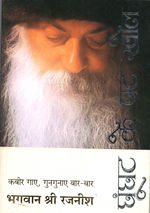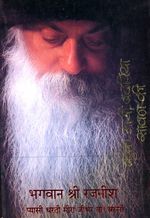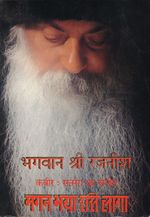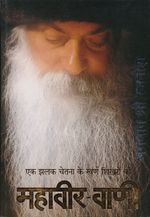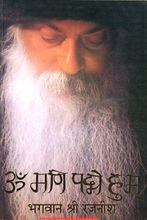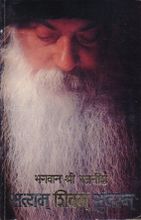Talk:Mahaveer-Vani (महावीर-वाणी) (mini-compilation): Difference between revisions
(Created page with "The three talks in this small compilation are: :1: मंत्र : दिव्य-लोक की कुंजी . . . . . . . . . . . (Bhag 1, #1, 18/08/1971) :2: सम...") |
No edit summary |
||
| Line 7: | Line 7: | ||
---- | ---- | ||
We are informed by [[Sw Shailendra Saraswati|Shailendra]] that in 1988, to spread Osho's words, Rajneeshdham / The Rebel Publishing House published many cheaper, abridged booklets, so people could have a taste more easily. At least | We are informed by [[Sw Shailendra Saraswati|Shailendra]] that in 1988, to spread Osho's words, Rajneeshdham / The Rebel Publishing House published many cheaper, abridged booklets in Hindi, so people could have a taste more easily. At least seven unusual editions are known from this time: | ||
:[[Ghoonghat Ke Pat Khol (घूंघट के पट खोल)]], four complete discourses on Kabir from the "larger" ''[[Suno Bhai Sadho (सुनो भाई साधो)]]'' -- larger ie in that it had ten talks from ''[[Kasturi Kundal Basai (कस्तूरी कुंडल बसै)]]'' augmenting its original ten. | :''[[Ghoonghat Ke Pat Khol (घूंघट के पट खोल)]]'', four complete discourses on Kabir from the "larger" ''[[Suno Bhai Sadho (सुनो भाई साधो)]]'' -- larger ie in that it had ten talks from ''[[Kasturi Kundal Basai (कस्तूरी कुंडल बसै)]]'' augmenting its original ten. | ||
:[[Jhuk Aayee Badariya Sawan Ki (झुक आयी बदरिया सावन की) (abridged)]], one complete discourse and five small portions from ''Pad Ghunghroo Bandh'', the unofficial "master" title for two books on Meera, ''Jhuk'' and ''[[Maine Ram Ratan Dhan Payo (मैंने राम रतन धन पायो)]]''. | :''[[Jhuk Aayee Badariya Sawan Ki (झुक आयी बदरिया सावन की) (abridged)]]'', one complete discourse and five small portions from ''Pad Ghunghroo Bandh'', the unofficial "master" title for two books on Meera, ''[[Jhuk Aayee Badariya Sawan Ki (झुक आयी बदरिया सावन की)|the original Jhuk]]'' and ''[[Maine Ram Ratan Dhan Payo (मैंने राम रतन धन पायो)]]''. | ||
:[[Magan Bhaya Rasi Laga (मगन भया रसि लागा)]], two complete discourses plus three partial ones on Kabir, all from the "larger" version of ''[[Kahai Kabir Diwana (कहै कबीर दीवाना)]]'', ie after its merger with ''[[Mera Mujhmein Kuchh Nahin (मेरा मुझमें कुछ नहीं)]]''. | :''[[Magan Bhaya Rasi Laga (मगन भया रसि लागा)]]'', two complete discourses plus three partial ones on Kabir, all from the "larger" version of ''[[Kahai Kabir Diwana (कहै कबीर दीवाना)]]'', ie after its merger with ''[[Mera Mujhmein Kuchh Nahin (मेरा मुझमें कुछ नहीं)]]''. | ||
:[[Mahavir Vani (महावीर वाणी) (mini-compilation)]], this one, with just three complete discourses. | :''[[Mahavir Vani (महावीर वाणी) (mini-compilation)]]'', this one, with just three complete discourses. | ||
:[[Om Mani Padme Hum (ॐ मणि पद्मे हुम्)]], nine partial discourses translated from the English series ''[[Om Mani Padme Hum]]''. This is the only known translation of that series, | :''[[Om Mani Padme Hum (ॐ मणि पद्मे हुम्)]]'', nine partial discourses (whole Q&A's) translated from the English series ''[[Om Mani Padme Hum]]''. This is the only known translation of that series. | ||
:''[[Raso Vai Sa (रसो वै स)]]'', fifteen partial discourses (whole Q&A's) translated from the English series ''[[Satyam Shivam Sundram]]''. This is not the only known translation of that series, but the twist is that the only other one is just below, also a member of this class of mini-compilations. | |||
:''[[Satyam Shivam Sundaram (सत्यम् शिवम् सुंदरम्)]]'', eleven partial discourses (whole Q&A's) translated from the English series ''[[Satyam Shivam Sundram]]'', but all different from ''Raso Vai Sa'' above. | |||
One of the most striking aspects of this group of mixed, abridged compilations is their covers. In fact, this is what alerted me to the phenomenon. All | One of the most striking aspects of this group of mixed, abridged compilations is their covers. In fact, this is what alerted me to the phenomenon. All use the same fairly studious picture of Osho. Shailendra speculates that it was probably to make a set of books with same look. This same look in a group of books aimed at new readers we might even call a kind of "branding". Whatever, here are the covers: | ||
<gallery widths=150px heights=220px > | <gallery widths=150px heights=220px > | ||
image:Ghoonghat ke pat khol cover.jpg|Ghoonghat | image:Ghoonghat ke pat khol cover.jpg|Ghoonghat | ||
| Line 20: | Line 22: | ||
image:Magan bhaya 1988 cover.jpg|Magan Bhaya | image:Magan bhaya 1988 cover.jpg|Magan Bhaya | ||
image:Mahavir vani (mini-compilation) cover.jpg|Mahavir Vani | image:Mahavir vani (mini-compilation) cover.jpg|Mahavir Vani | ||
image:Om Mani Padme Hum cover.jpg|OMPH | image:Om Mani Padme Hum cover.jpg|OMPH (trans) | ||
image:Raso Vai Sa 1988 cover.jpg|Raso Vai Sa (trans) | |||
image:Satyam Shivam trans 1988 cover.jpg|SSS (trans) | |||
</gallery> | </gallery> | ||
All are copyright by "Rajneshdham" and published by "The Rebel Publishing House" in 1988; it should be noted that these corporate entities also | All are copyright by "Rajneshdham" and published by "The Rebel Publishing House" in 1988; it should be noted that these corporate entities were not limited to this kind of thing, also publishing lots of normal editions as well as some "special deluxe" editions. It seems that Rajneeshdham was only in operation in 1987 and 1988. -- doofus-9 16:45, 5 September 2017 (UTC), updated 05:31, 11 November 2017 (UTC) | ||
Revision as of 05:31, 11 November 2017
The three talks in this small compilation are:
- 1: मंत्र : दिव्य-लोक की कुंजी . . . . . . . . . . . (Bhag 1, #1, 18/08/1971)
- 2: समय और मृत्यु का अंतर्बोध . . . . . . . . . .(Bhag 2, #10, 13/09/1972)
- 3: अलिप्तता और अनासक्ति का भावबोध . . (Bhag 2, #11, 14/09/1972)
("Bhag 1" and "Bhag 2" refer to the original volume numbers.)
We are informed by Shailendra that in 1988, to spread Osho's words, Rajneeshdham / The Rebel Publishing House published many cheaper, abridged booklets in Hindi, so people could have a taste more easily. At least seven unusual editions are known from this time:
- Ghoonghat Ke Pat Khol (घूंघट के पट खोल), four complete discourses on Kabir from the "larger" Suno Bhai Sadho (सुनो भाई साधो) -- larger ie in that it had ten talks from Kasturi Kundal Basai (कस्तूरी कुंडल बसै) augmenting its original ten.
- Jhuk Aayee Badariya Sawan Ki (झुक आयी बदरिया सावन की) (abridged), one complete discourse and five small portions from Pad Ghunghroo Bandh, the unofficial "master" title for two books on Meera, the original Jhuk and Maine Ram Ratan Dhan Payo (मैंने राम रतन धन पायो).
- Magan Bhaya Rasi Laga (मगन भया रसि लागा), two complete discourses plus three partial ones on Kabir, all from the "larger" version of Kahai Kabir Diwana (कहै कबीर दीवाना), ie after its merger with Mera Mujhmein Kuchh Nahin (मेरा मुझमें कुछ नहीं).
- Mahavir Vani (महावीर वाणी) (mini-compilation), this one, with just three complete discourses.
- Om Mani Padme Hum (ॐ मणि पद्मे हुम्), nine partial discourses (whole Q&A's) translated from the English series Om Mani Padme Hum. This is the only known translation of that series.
- Raso Vai Sa (रसो वै स), fifteen partial discourses (whole Q&A's) translated from the English series Satyam Shivam Sundram. This is not the only known translation of that series, but the twist is that the only other one is just below, also a member of this class of mini-compilations.
- Satyam Shivam Sundaram (सत्यम् शिवम् सुंदरम्), eleven partial discourses (whole Q&A's) translated from the English series Satyam Shivam Sundram, but all different from Raso Vai Sa above.
One of the most striking aspects of this group of mixed, abridged compilations is their covers. In fact, this is what alerted me to the phenomenon. All use the same fairly studious picture of Osho. Shailendra speculates that it was probably to make a set of books with same look. This same look in a group of books aimed at new readers we might even call a kind of "branding". Whatever, here are the covers:
-
Ghoonghat
-
Jhuk Aayee
-
Magan Bhaya
-
Mahavir Vani
-
OMPH (trans)
-
Raso Vai Sa (trans)
-
SSS (trans)
All are copyright by "Rajneshdham" and published by "The Rebel Publishing House" in 1988; it should be noted that these corporate entities were not limited to this kind of thing, also publishing lots of normal editions as well as some "special deluxe" editions. It seems that Rajneeshdham was only in operation in 1987 and 1988. -- doofus-9 16:45, 5 September 2017 (UTC), updated 05:31, 11 November 2017 (UTC)
